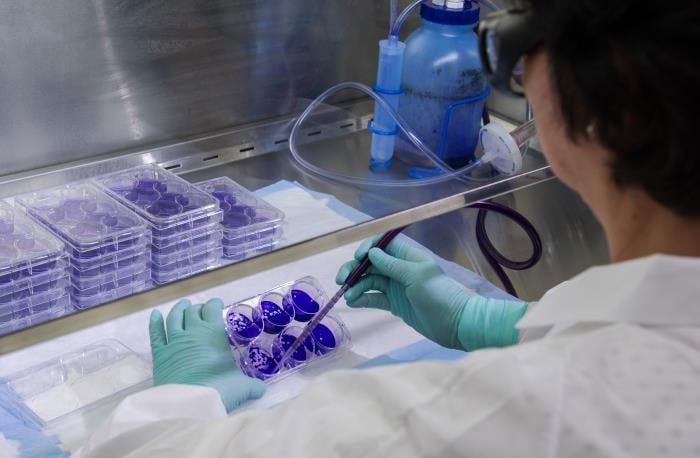Key points
- There are several ways diagnostic testing can detect poliovirus, and CDC laboratories conduct some of these tests.
- Get information about testing methods and how to collect, store, and ship samples.
- Submissions to CDC for diagnostic testing require pre-approval.

Overview
Diagnostic testing can detect poliovirus in specimens from the throat, feces (stool), and occasionally cerebrospinal fluid (CSF). Testing works by isolating the virus in cell culture or by detecting the virus by polymerase chain reaction (PCR).
CDC laboratories conduct testing for poliovirus, including:
- Culture
- Intratypic differentiation
- Genome sequencing
- Serology
Test methods
Virus isolation and detection
Virus isolation in culture is the most sensitive method to diagnose poliovirus infection. Poliovirus is most likely to be isolated from stool specimens. It may also be isolated from pharyngeal swabs. Isolation is less likely from blood or CSF.
To increase the probability of isolating poliovirus, collect at least 2 stool specimens 24 hours apart from patients with suspected poliomyelitis. These should be collected as early in the course of disease as possible (ideally within 14 days after onset).
Real-time reverse transcription PCR is used to differentiate possible wild strains from vaccine-like strains ("intratypic differentiation"). Virus isolated in culture is used as the starting material.
Partial genome sequencing is used to confirm the poliovirus genotype and determine its likely geographic origin.
Serology testing
Serology may be helpful in supporting the diagnosis of paralytic poliomyelitis; particularly if a patient is known or suspected to not be vaccinated.
An acute serum specimen should be obtained as early in the course of disease as possible. A convalescent specimen should be obtained at least 3 weeks later.
Cerebrospinal fluid analysis
Detection of poliovirus in CSF is uncommon. CSF usually contains an increased number of leukocytes [from 10 to 200 cells/mm3 (primarily lymphocytes)]. CFS also contains a mildly elevated protein (from 40 to 50 mg/dL). These findings are nonspecific and may result from a variety of infectious and noninfectious conditions.
Specimen collection
CDC's Infectious Disease Laboratories provide guidance for various specimen collection, storage, and shipment, including for polio. Refer to the Infectious Diseases Laboratories Test Directory entry for each test.
Submitting specimens
In addition to the information found on the CDC Infectious Diseases Laboratories Test Directory entry for each test, follow the guidance below for specimen collection and shipping. The instructions also include points of contact for the tests.
Contact health department first
Before submitting to CDC
You must request pre-approval for all submission to CDC for diagnostic testing. This is because specimen submission requirements for CLIA diagnostic testing are currently being updated. Please contact us at PicornaLab@cdc.gov.
Instructions for test types
Stool testing for polio diagnostics
- Polio isolation and genotyping instructions (Test CDC-10376)
- Polio "special study" instructions (Test CDC-10378)
Stool testing for polio clinical trials
- Polio cell culture isolation for clinical trials (Test CDC-10548)
- Polio direct detection and titration instructions (CCID50 assay; Test CDC-10549)
